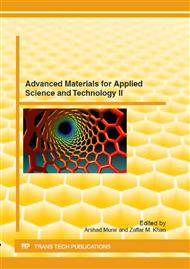p.1
p.9
p.15
p.25
p.37
p.43
p.53
p.63
p.79
Microstructure Study of Propellant Binder
Abstract:
Mechanical properties of HTPB (binder) strongly depend on its microstructure. Microstructure of HTPB consists of three major configurations cis, trans and vinyl. The contents of these configurations in the backbone of polymer chain determine the properties of end products. So it is very important to control and determine the ratios of cis, trans and vinyl in HTPB. HTPB was prepared by free radical polymerization of butadiene initiated by hydrogen peroxide in ethanol as solvent. Quantity of the initiator and polymerization time was varied in different experiments. The resulting polymers were analyzed for hydroxyl value (OH value), number average molecular weight (Mn) and viscosity (η). The results indicated that these properties were highly affected by the variation in initiator ratios and reaction time. Microstructure of the polymers was determined by FTIR spectroscopy using ATR (Attenuated Total Reflectance) assembly. Calibration curve was plotted for each functional group (cis, trans and vinyl) using corrected peak values from the spectra (corrected using cis: 804.7 to 640.1 cm-1; trans: 978.8 to 944.9 cm-1; vinyl: 927.7 to 895.2 cm-1). Cis, trans and vinyl contents of the polymers were calculated from the calibration curve. The data indicated that although the variation of initiator quantity and polymerization time affected OH value, Mn and η severely but microstructure variations were quite insignificant.
Info:
Periodical:
Pages:
37-42
Citation:
Online since:
September 2012
Price:
Сopyright:
© 2012 Trans Tech Publications Ltd. All Rights Reserved
Share:
Citation:


